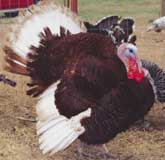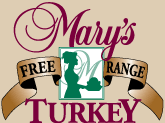|
Raising
Heritage Turkeys
Think heritage turkeys might be a
niche for your farm? Frank Reese and Dr.
Don Bixby offer some issues to consider
before you start.

Know
your markets. Who do you
plan to sell to? Local restaurants?
Grocery stores? Slow Food members? "Who"
will determine what you feed, how to
process your bird, and the price your
market will bear.
Find
your feed source. Reese
sold his bird for $3.50 per pound in
2002. When Slow Food asked to feed his
turkeys certified organic feed this
year, his feed costs suddenly doubled.
He increased his price to $4.00 per
pound this year.
Locate
your processing facility.
Finding a plant that will process small
numbers of the dark feathered birds may
be tricky. Research your state's food
safety regulations to determine state or
federal inspection requirements.
Start
small. Heritage turkeys
can be a handful. Frank Reese recommends
new growers first try 50 to 60 poults.
Order
poults early. If
interested in raising heritage turkeys
for 2004, Bixby recommends you think
about it now. With current demand
greater than supply, many hatcheries
will sell out of heritage poults as
early as March.
Put them
to work. Turkeys are
working animals. They thrive when they
have a job to do. Have a plan to use the
birds ― be it for meat, soil fertility
or pest control.
Consider becoming a breeder
if you enjoy the birds. Having been a
turkey breeder for years, Reese knows
knowledgeable turkey breeders are almost
as rare as the turkeys themselves.
|
|
|
Resources
American Livestock Breeds Conservancy
(ALBC)
P.O. Box 477
Pittsboro, North Carolina 27312
www.albc-usa.org
(919) 542-5704
A member-supported organization
dedicated to the preservation of genetic
diversity in livestock poultry species.
Members get ALBC's bi-monthly
newsletter, their annual breeders
directory and access to ALBC surveys and
research.
All
American Turkey Growers Club,
C/O Danny Williamson
3441 Mustang
Tampa, Kansas 67483
(785) 227-5149
brahmabrama@hotmail.com
A network of North American turkey
breeders committed to teaching and
expanding the art of traditional turkey
breeding.
Slow
Food USA
434 Broadway, 6th Floor
New York, NY 10013
(212) 965-5640
www.slowfoodusa.org
An educational organization committed
to preserving rare food and food
traditions. Visit the Web site for press
coverage on heritage turkeys.
Eat
Well Guide
Product of the Institute for Agriculture
and Trade Policy
www.eatwellguide.org
An online, national guide to find
heritage, organic and sustainably grown
turkeys raised without routine
antibiotics.
|
|
|
November 21, 2003: This holiday
season, thousands of Americans will forgo their normal
Large White turkey to enjoy a different kind of bird.
"Heritage" turkeys are enjoying a culinary comeback.
Thanks to the joint efforts of breed
conservationists, farmers and a consumer's movement
called Slow Food, demand for heritage turkeys surged in
2003. A new niche in a corporate controlled market,
heritage turkeys are helping bring turkey genetics and
profits back to the farm.
Heritage
Turkeys
"Heritage" is a new term for what the industry calls
"standard" turkeys. These birds, eight varieties in
total, were bred according to the color and stock
Standard of Perfection recognized by the American
Poultry Association in the late 1800s.
Smart, colorful birds raised in barnyards and
pastures, standard turkeys -- such as the Narragansett,
Buff and Slate -- provided meat, eggs, and on-farm pest
control until the 1950s. As the turkey industry became
more concentrated, large corporations eventually
monopolized turkey production and breeding. By the 1970s
commercially bred birds, developed solely for meat
production and easy processing, displaced the standard
turkeys.
The Large White turkey now accounts for 90 percent of
the commercial market with breeding stock held by three
international companies ― Hybrid Turkeys, British United
Turkeys and Nicholas Turkey Breeding Farms. Though
today's turkey is cheaper and more plentiful, it's come
at a price.
Bred solely for meat, the Large Whites have lost
their natural abilities to fly, run or mate
― a fact
that raises concerns for many consumers interested in
animal welfare issues. Widespread routine antibiotic use
to prevent illness, a common practice in large-scale
turkey operations, is also raising public health
concerns. For all it's white breast meat, more people
are starting to think the Large Whites lack flavor.
In 1997 the American Livestock Breed Conservancy
(ALBC), an organization that conserves rare breeds and
genetic diversity in livestock, surveyed North American
turkey populations to assess the genetic status of the
breed. They made an alarming discovery -- a number of
the standard turkey varieties including the Buff,
Narragansett and Slate were on the verge of extinction.
Bourbon Red was close behind.
As one of the only domesticated animals to originate
in North America,
preservation of the rare breeds is like preserving a
historical building or rare document. It's a piece of
American history. For turkey growers, heritage birds
hold important genetic traits (such disease resistance
and temperament) critical to the turkey's long-term
health and survival.
Slow Food quick to the rescue
Though groups like the All-American Turkey Growers
Club and the Society for Preservation of Poultry
Antiquities worked for years to breed and preserve rare
turkey varieties, it is a unique partnership with
consumers that is catapulting heritage turkeys to the
radar screen of food lovers nationwide.
Slow Food is an international movement of people
committed to the perpetuation of unique foods and
processes endangered by agricultural standardization.
Started in
Italy
22 years ago, Slow Food is now 80 countries and 70,000
members strong.
Among its projects is the Ark of Taste. Primarily a
media tool, Slow Food uses it to identify and promote
plant and animal breeds in jeopardy of extinction. In
doing so, Slow Food hopes to build awareness and create
market incentives for farmers to protect them.
When Slow Food
USA
formed in 2000, Dr. Don Bixby, technical programs
director for ALBC, saw an opportunity to help the
turkey. He nominated four varieties
― the American
Bronze, Bourbon Red, Jersey Buff, and Narragansett - for
entry into the USA Ark. The turkey's story -- which he
says is "so compelling and so American" -- was a natural
fit.
The turkeys joined the USA Ark in 2001 and Slow Food
started to promote them. The birds' dark, moist and
flavorful meat soon became a hit with chefs and food
writers.
In 2002, 5,000 heritage birds were sold at
Thanksgiving. This year the turkey population has
doubled. Though still a tiny fraction of the industry's
270 million birds, it's a giant step toward the heritage
turkey's preservation.
Heritage turkey farmers
With market demand for the turkeys growing rapidly in
2003, Slow Food and ALBC approached growers across the
country to raise heritage birds by a set of production
standards. Farmers agreed to raise birds from one of the
four varieties and promised to grow the birds in a "free
range, preferably organic, and sustainable manner." In
return, farmers would get a price of $3.50 to 4.00 per
pound and free publicity.
According to Patrick Martin, Slow Food USA's director, the grower response
has been "very positive."
Heritage birds command a premium (consider a
store-bought turkey at 39 cents per pound) because of
their genetic value and added labor costs. They are, on
average, much smaller birds (10 lbs. for hens, 12 lbs. for
toms) that take twice as long to mature as the Large
Whites. Still, Frank Reese, an experienced heritage
turkey farmer (Good Shepherd Ranch in Linsborg, Kansas,
www.reeseturkeys.com), estimates that if done
properly, growers can make a nice profit of $60 to $80
per bird. Thanks to careful selection and breeding, his
heritage birds average 18 - 33 pounds. (Reese and other
heroes in conserving heritage turkeys are recognized by
the ALBC at
www.albc-usa.org/alerts/Oct13_03.htm)
Has the expensive price turned people away? Not yet,
where marketing is done well. Well-established players
in the free range and organic turkey industry, Mary and
Rick Pittman of Mary's
Turkeys (www.marysturkeys.com)
agreed to raise heritage turkeys for Slow Food this
year. Seeing the potential market for the birds, they
raised an additional 1,000 Narragansetts and Bourbon
Reds. By the end of October they sold out of heritage
turkeys and continue to get requests.

Amy Kenyon, who raises turkeys and grass-fed
livestock (Skate Creek Farms in Meredith, New York),
expects to sell out of her Bourbon Reds and Standard
Bronze this year. She sees potential for many more next
year.
For farmers that direct market, Slow Food's free
publicity is an added benefit. "Their access to food
writers and restaurants has been key to increasing
awareness about the turkeys," says Bixby. Articles in
the New York Times, LA Times, USA Today and many
regional papers have increased interest in the birds and
their growers.
As Mary's
Turkeys
prepare to sell their birds nationally this year, Mary
Pitman says the added farm publicity has been
invaluable. "All it took was one-half hour radio talk
show" with food guru Gene Burns to help promote the
farm. Though it aired in August, she continues to get
calls daily about that show.
Besides the financial rewards, growers enjoy the
lively character the birds bring to the farm. "You
either love them or hate them," says Reese who raised
3,000 heritage turkeys this year. He fondly adds, "They'll get into everything." Kenyon admits that their
turkeys have had "the run of the farm," but she adds
that the turkeys have been fun to raise and profitable
as well.
Heritage turkeys aren't without their challenges.
Managing predators, modifying consumer expectations and
finding adequate processing facilities are important
management challenges for turkey growers. Like any new
venture, Reese says growers should "expect two to five
years to establish markets" and hone their systems.
Are heritage turkeys a fad or a long-term market? If
groups like Slow Food continue to spark consumer
interest, Dr. Bixby thinks these breeds will enjoy a
revival. He's hopeful that more awareness of heritage
turkeys will pave the way for other rare breed markets
as well. In the meantime, for innovative farmers willing
to raise poultry, heritage turkeys are an opportunity to
diversify, make money and preserve an American
tradition.
Despite all the current hoopla, Reese believes the
heritage turkey's fate will truly be secure only when
growers bring turkey breeding back to the farm.
Kristen Corselius is
a program associate with the Institute for Agriculture
and Trade Policy (Minneapolis, MN).
For questions or comments, please contact Kristen at
kcorselius@iatp.org.
|







